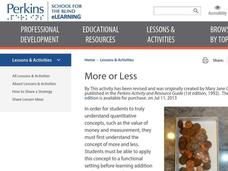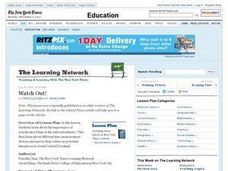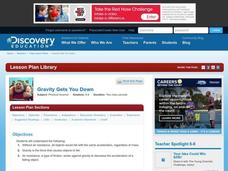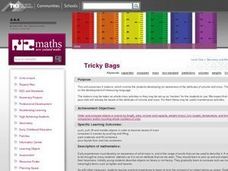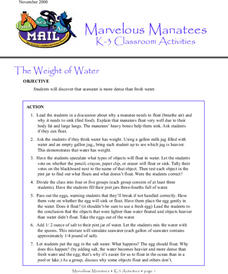Illustrative Mathematics
Longer and Heavier? Shorter and Heavier?
For many young children it seems obvious that longer objects are heavier than shorter objects. This assumption is put to the test as the class investigates the relationship between length and weight in a whole-group activity. Using a...
Illustrative Mathematics
Which Weighs More? Which Weighs Less?
Expand the the comparative language of young mathematicians with a hand-on weight measurement activity. Working independently or in pairs, children compare the weight of large wooden blocks to various other classroom objects, recording...
Curated OER
Science: Objects That Rotate with Gravity
Students conduct experiments in gravity by rolling objects down an incline and determining which ones roll slower than others. As part of the experiment, they design objects which will roll the slowest. Using digital movie cameras or...
Perkins School for the Blind
More or Less
The concept of more or less is one that needs to be mastered prior to learning other concepts such as quantitative analysis, addition, or subtraction. This activity provides several ways to teach learners with low or no vision to...
Curated OER
Comparing and Ordering Numbers
Students compare, order, and measure objects. In this measurement lesson, students are assessed on their ability to order, compare, and measure objects. This is an assessment only lesson and does not include instruction.
NASA
Newton Car
If a car gets heavier, it goes farther? By running an activity several times, teams experience Newton's Second Law of Motion. The teams vary the amount of weight they catapult off a wooden block car and record the distance the...
Curated OER
Pounds
For this mathematics worksheet, 1st graders identify which items pictured weighs more or less than a pound. Then they circle the objects that weigh more and place an X on the object that weigh less than a pound.
Curated OER
Density - An Introduction
Students experiment with objects of different densities. In this density lesson, students examine same-sized objects with different weights, then look at a teacher explanation of density. Students make wave bottles and a density jar to...
Curated OER
Watch Out!
First graders experiment with different sized balls and an incline plane to study how a heavy object push a lighter object. They examine the safety message of this instructional activity by showing their drawings of the crossbuck sign.
Curated OER
Gravity Gets You Down
Students design an experiment to investigate how objects with different masses fall. In this physics lesson, students predict how these objects will fall in a vacuum tube. They write a report explaining experimental results and conclusion.
Curated OER
The Magic School Bus Gains Weight
Students learn along with Ms. Frizzle's class. For this Magic School Bus lesson plan, students test whether gravity makes heavier things fall faster than lighter ones.
Curated OER
Volume and Mass: Identify the Attribute
Young scholars rotate through five studying stations related to the attributes of volume and mass. They manipulate objects to explore mass, compare two masses by pushing and lifting, pack materials and fill containers, and pour liquids...
Curated OER
Density Lab Activities
Pupils participate in several density lab activities in order to clarify the misconceptions that solids sink and liquids float. Students work with triple beam balances to find mass of objects to calculate density.
Curated OER
Catapults!
Learners work together to discover the relationship between the angle of catapults and the flight of different objects. They discover the heavier the object the more force is needed. They examine how engineers use this information to...
Curated OER
Seesaws
Students make direct comparisons between objects using balance and spring scales. They also are encouraged to estimate which object is heavier by holding the objects before using the balance scales. Comparing the masses of objects is the...
Curated OER
Mass
Students determine how mass is a property of an object that can be measured, and examine how size affects mass. They work with balances and determine what units of measurement are associated with mass. Finally, they determine the...
Alabama Learning Exchange
What Is An Inch?
Students identify the length of an inch. In this measurement lesson, students read Inch by Inch and predict how many inches long various objects are. Students practice measuring the objects by using an inch ruler.
Curated OER
The Law of Inertia
Students practice the 4 question strategy to form more questions and develop further experiments. The four questions are engage, explore, explain, and elaborate. They use the 4 question strategy on an investigation involving the mass...
Curated OER
How Can You See Which Soda Has More Sugar?
Sixth graders weigh regular and diet soda to see which one is heavier and therefore which one contains more sugar. In this soda lesson plan, 6th graders discover that regular soda contains more sugar because it weighs more.
Curated OER
Momentum
Pupils explore the concept of "transfer of momentum". In this physics lesson, students observe the results of two objects or people as they make contact in different ways. Pupils on roller blades and model cars of different weights are...
Curated OER
How Do Things Fall?
Students observe falling objects. They discover the rate of falling is based on air resistance and not the weight of the objects. They discuss how engineers use this type of information to design aerodynamic shapes.
Curated OER
The Same But Different
Fourth graders identify the characteristics of a simple physical change. They describe objects by the properties of the materials from which they are made. Students discuss the different states of matter and their distinct physical...
Curated OER
Timing An X-ray Pulsar
Students use X-ray data to identify an object as a rotating neutron star, and determine its period of rotation. They use XTE observations of the Crab Pulsar to determine the period of the light intensity, interpret this period as the...
Curated OER
The Weight of Water
Students participate in an experiment about the weight of water. They work together to discover that seawater is more dense than fresh water. They also determine which objects float and sink.



